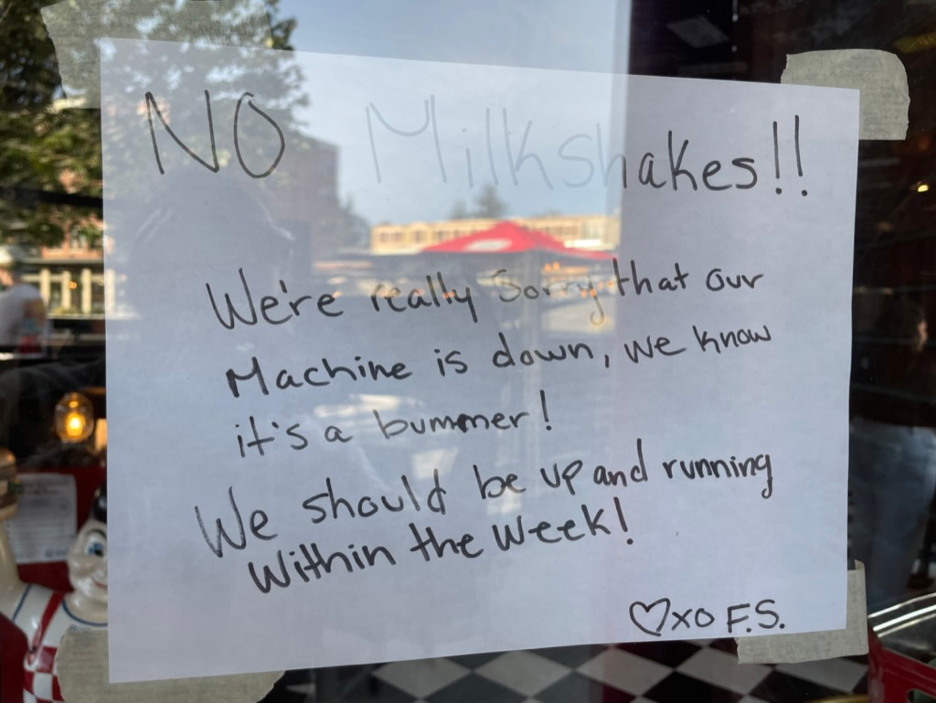Share article
A brand voice is the personality and tone of a company's communication, and it’s important because it can set the stage for every interaction your clients have with your business.
A strong brand voice makes all the difference between success and struggle. I highly recommend putting time into defining what you want that voice to be, because companies with engaging personalities draw in their audience, and people fall in love with brands that share personality.
Brand voice in action
There is a local brewery called GRUFF Brewing Co. As their name indicates, they're a rather irreverent brand. A sign they have at the bar sums them up perfectly.

Another local favorite is a burger shop set up like an old-school diner with a carhop-type theme. They're super friendly, fun, and engaging. I showed up with my mom, who was looking forward to a milkshake. We rounded the corner and saw a sign on their door that was SO THEM. I could hear the staff saying all this, empathizing with their customers.

Consistency matters
Consistency in your brand voice can make your company memorable. Of course, this can be good or bad, depending on the voice and the match with your target audience. To build trust, you must find and be consistent with that match.
For example, if your target audience is executives, your voice speaks to executives, and you use it consistently, you'll add to the trust with each interaction. But if your goal is to appeal to executives, and your company voice uses trendy language more suited for the youngest generation, we have an offset that doesn't resonate.
Your brand voice can be whatever you want it to be. You're not limited to corporate speak or other "business" voices you've seen from others. Yours can be anything you want. You just need to remain consistent with it.
Inconsistency is a brand killer
When your brand doesn't match, it's jarring to your audience, and you create a disconnect that's hard to recover from.
Here’s an example.
I've used a company for transcription services whose brand was very okay. Not memorable. Not bad. Just a straightforward brand voice that wasn't too interesting.
But their mailing list? A different story. There, I saw LOADS of personality, so much so that I looked forward to reading their product promotion emails! Naturally, I wondered if they also upped their website copy to this new fun brand voice. I was sadly disappointed, seeing it in the same state I was familiar with - straightforward and rather dull.
I was so intrigued with the emails and curious about the disconnect in voice, that I sleuthed around to find out who their copywriter was. I reached out for a little conversation, and he was engaging and open about their situation—there was a giant disconnect within the internal team.
Eventually, the tone of the company emails changed. I looked up my LinkedIn conversations with the copywriter and saw that he had moved on. The engaging brand voice vanished with him. Now, the emails were straightforward and boring to match their website.
I unsubscribed.
Establish a consistent brand voice for your audience
There are many lessons here. You must embed your voice into every part of your company, and all published content must run through that brand voice filter. Select someone if you don't already have an editorial director on your team. This person should be responsible for the voice and being the advocate to ensure everything matches. The company's voice shouldn't change because the people do.
A clear and consistent brand voice can help attract the clients you want - those who identify with your company's personality, values, and messaging. These folks are more likely to become loyal fans and advocates.
How do you start?
Define your brand's personality and values
Think about the company's mission, vision, target audience, and the emotions and associations you want to evoke.
Create a style guide
Once you've defined the brand personality and values, create a style guide outlining the tone, language, and messaging used in all communications. Share the style guide with your team and use it consistently across all channels.
Monitor and adjust as necessary
As your company grows and evolves, its brand voice may need to change to reflect that evolution. Monitoring and adjusting can ensure you remain consistent and relevant.
Make consistency your goal
Who would you rather follow and engage with? The company that uses a different voice everywhere you see them, giving you a sense of confusion and whiplash? Or someone who knows who they are and what they stand for—and deliver?
I appreciate a fun brand, but "fun" doesn't need to be your goal. Consistency across communication and with the personalities on your team IS the goal.
Content provided by Q4intelligence
Photo by liudmilachernetska

